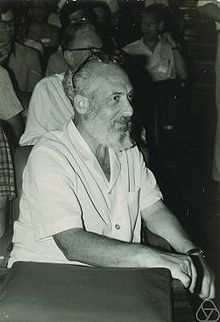Samuel Eilenberg
- Samuel Eilenberg
-
Samuel Eilenberg, né à Varsovie en 1913 et décédé à New York en 1998, est un mathématicien américain d'origine juive-polonaise.
Samuel Eilenberg fut professeur et chercheur en mathématiques à l'Université Columbia de 1947 à 1982. Il obtint son doctorat de mathématiques à l'Université de Varsovie en 1936 sous la direction de Karol Borsuk. Il quitta la Pologne pour les États-Unis d'Amérique en 1939. Il obtint un poste à l'université Columbia à New York en 1947 dans laquelle il continuera sa carrière.
Eilenberg privilégia la topologie algébrique, la théorie de l'homologie et la théorie des catégories dont lui et Saunders Mac Lane sont les pères fondateurs.
Eilenberg a aussi été membre-collaborateur du groupe Bourbaki. En 1956, Henri Cartan et Samuel Eilenberg sont les auteurs du livre Homological Algebra qui est un classique en mathématique. Depuis 1966, il s'intéressa à la théorie des automates et y contribua en écrivant le livre Automata, Langages and Machines.
Samuel Eilenberg fut aussi un collectionneur d'art et fit don de sa collection au Metropolitan Museum de New York.
Distinctions et récompenses
Colauréat du Prix Wolf en mathématique avec Atle Selberg.
Liens externes
Wikimedia Foundation.
2010.
Contenu soumis à la licence CC-BY-SA. Source : Article Samuel Eilenberg de Wikipédia en français (auteurs)
Regardez d'autres dictionnaires:
Samuel Eilenberg — (1970) Samuel Eilenberg (* 30. September 1913 in Warschau, Generalgouvernement Warschau; † 30. Januar 1998 in New York, USA) war ein polnischer Mathematiker. Zusammen mit Saunders Mac Lane gilt er als Begründer … Deutsch Wikipedia
Samuel Eilenberg — Saltar a navegación, búsqueda Samuel Eilenberg (1970) Samuel Eilenberg (30 de septiembre de 1913 30 de enero de 1998) fue un matemático polaco. Nació en Varsovia (Polonia) y murió en … Wikipedia Español
Samuel Eilenberg — (30 de septiembre de 1913 30 de enero de 1998) fue un matematico polaco. Nació en Varsovia (Polonia) y murió en Nueva York (Estados Unidos. La topología fue su principal interés: trabajó en el tratamiento axiomático de la teoría de la homología… … Enciclopedia Universal
Samuel Eilenberg — Infobox Scientist box width = name = Samuel Eilenberg image size = caption = Samuel Eilenberg (1970) birth date = birth date|1913|9|30 birth place = Warsaw, Russian Empire death date = death date and age|1998|1|30|1913|9|30 death place =… … Wikipedia
Eilenberg — is a surname, and may refer to:* Samuel Eilenberg, Polish mathematician * Richard Eilenberg, German composer, see German article.;named after Samuel: * Eilenberg MacLane space * Eilenberg Moore algebra * Eilenberg Steenrod axioms See also *… … Wikipedia
Eilenberg — ist der Name eines Ortsteils von Neustadt (Wied) im rheinland pfälzischen Landkreis Neuwied Eilenberg ist auch der Nachname mehrerer Personen: Richard Eilenberg (1848–1925), deutscher Komponist Samuel Eilenberg (1913–1998), polnischer… … Deutsch Wikipedia
Samuel — Saltar a navegación, búsqueda Samuel El profeta Samuel, en un fresco del monasterio de Mikhailovskr, Kiev (1112) Origen Hebreo Género … Wikipedia Español
Eilenberg-Steenrod-Axiome — Der Begriff der Homologietheorie stammt aus der algebraischen Topologie und charakterisiert axiomatisch die Weise, wie beispielsweise die Singuläre Homologie oder die Bordismustheorien topologischen Räumen abelsche Gruppen zuordnen… … Deutsch Wikipedia
Eilenberg-Steenrod axioms — In mathematics, specifically in algebraic topology, the Eilenberg Steenrod axioms are properties that homology theories of topological spaces have in common. The quintessential example of a homology theory satisfying the axioms is singular… … Wikipedia
Eilenberg–Steenrod axioms — In mathematics, specifically in algebraic topology, the Eilenberg–Steenrod axioms are properties that homology theories of topological spaces have in common. The quintessential example of a homology theory satisfying the axioms is singular… … Wikipedia

